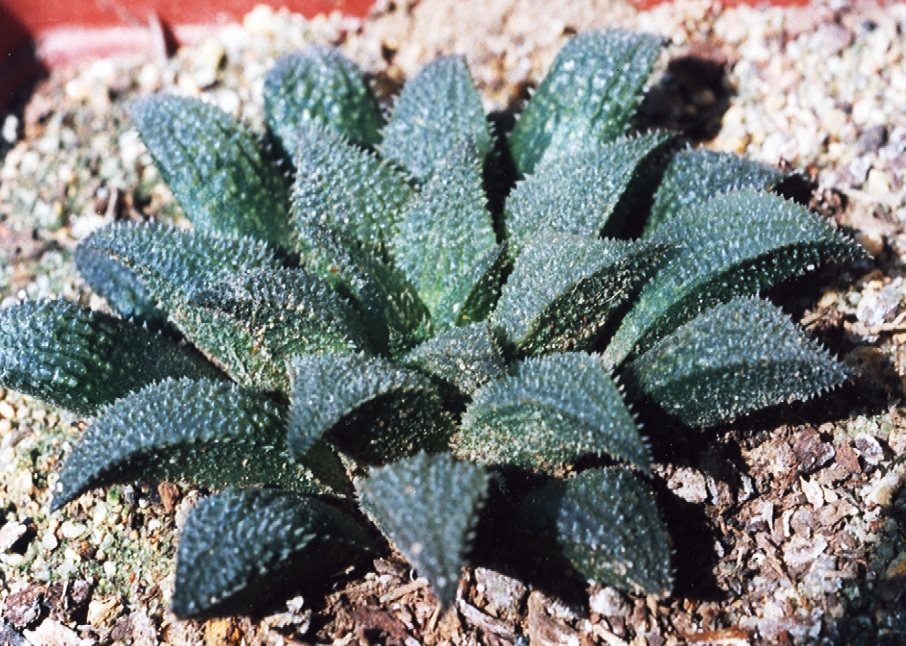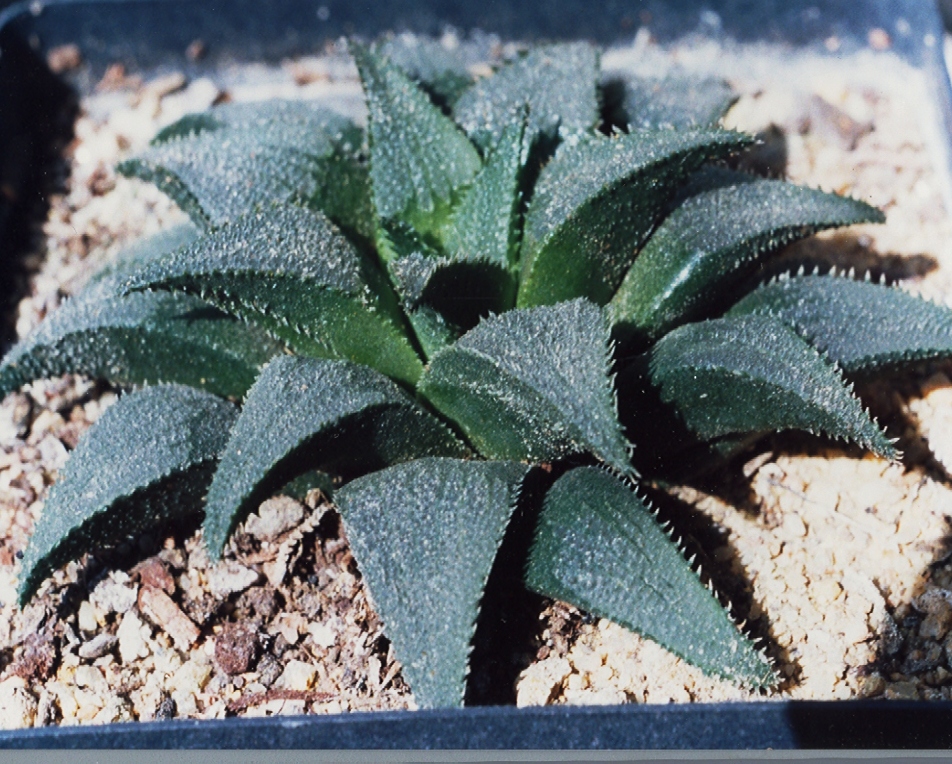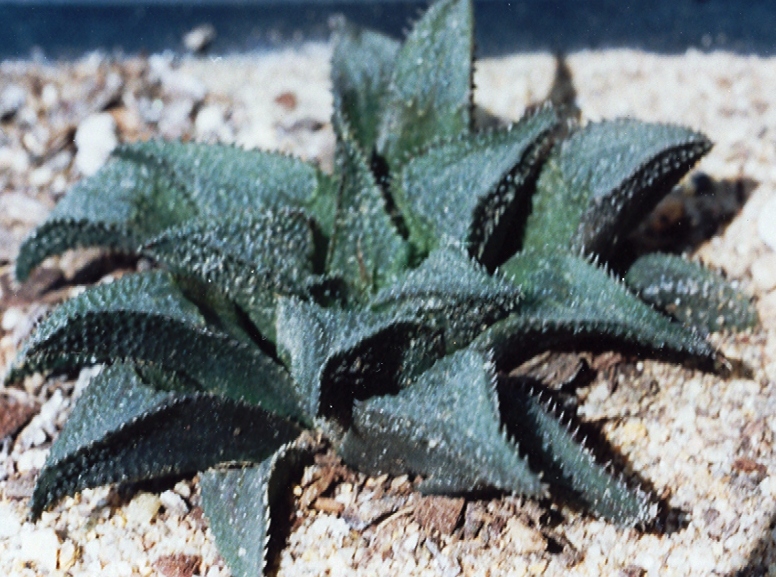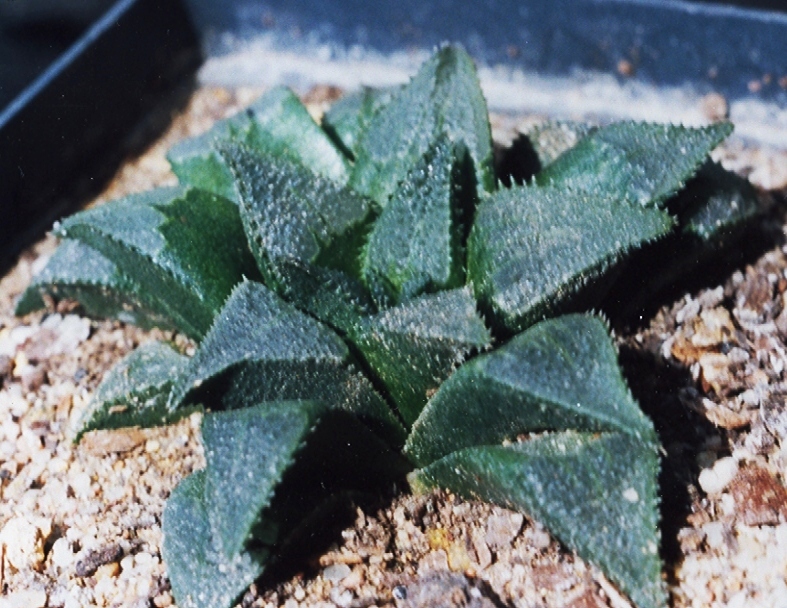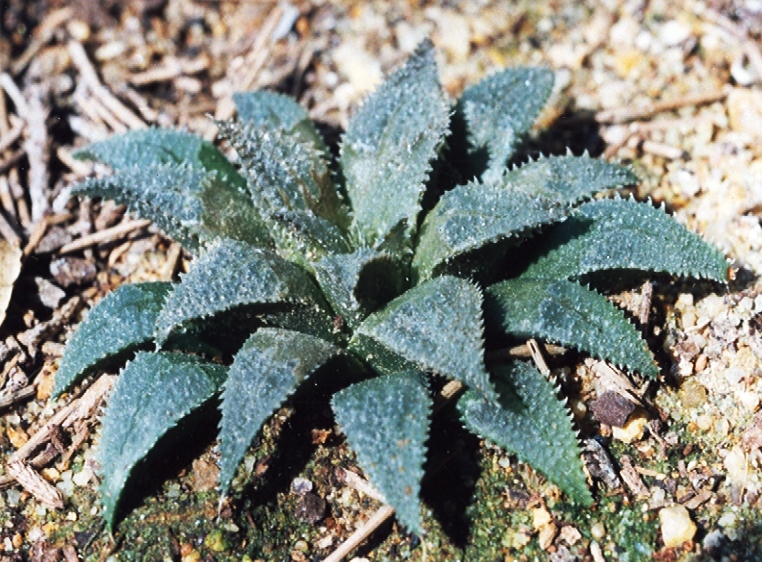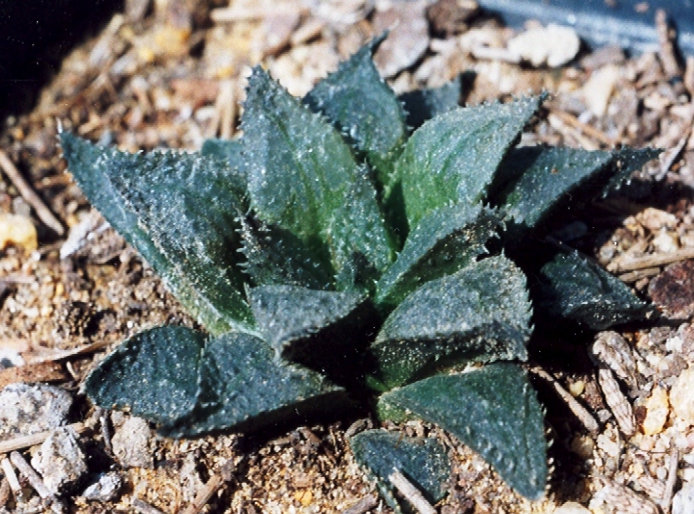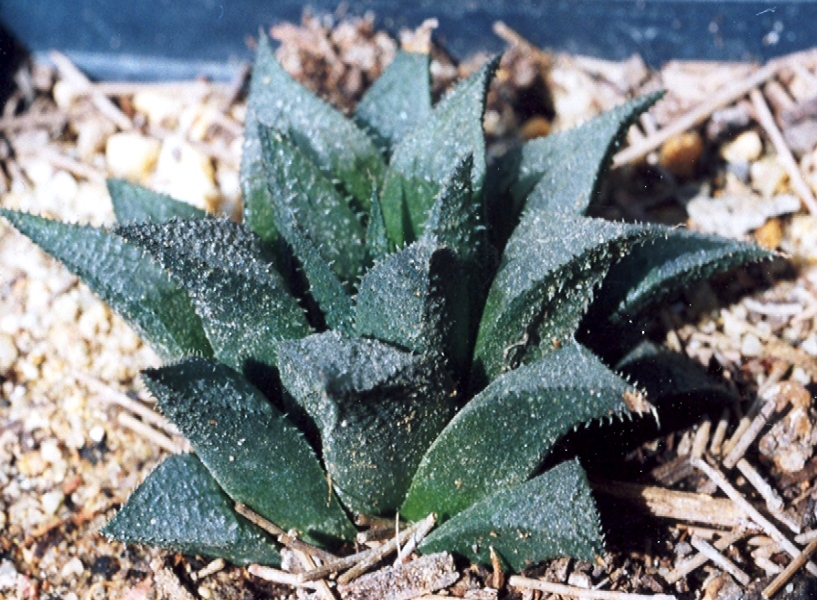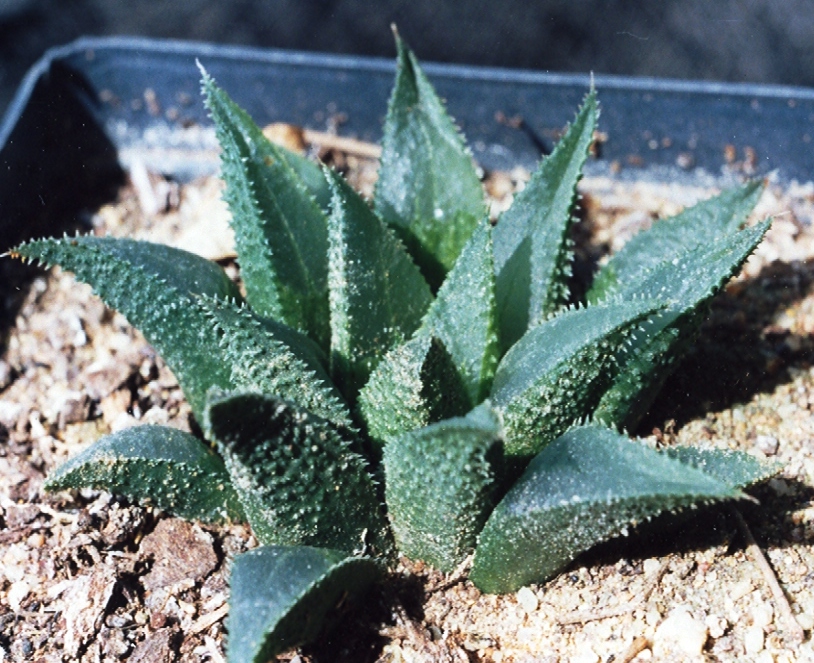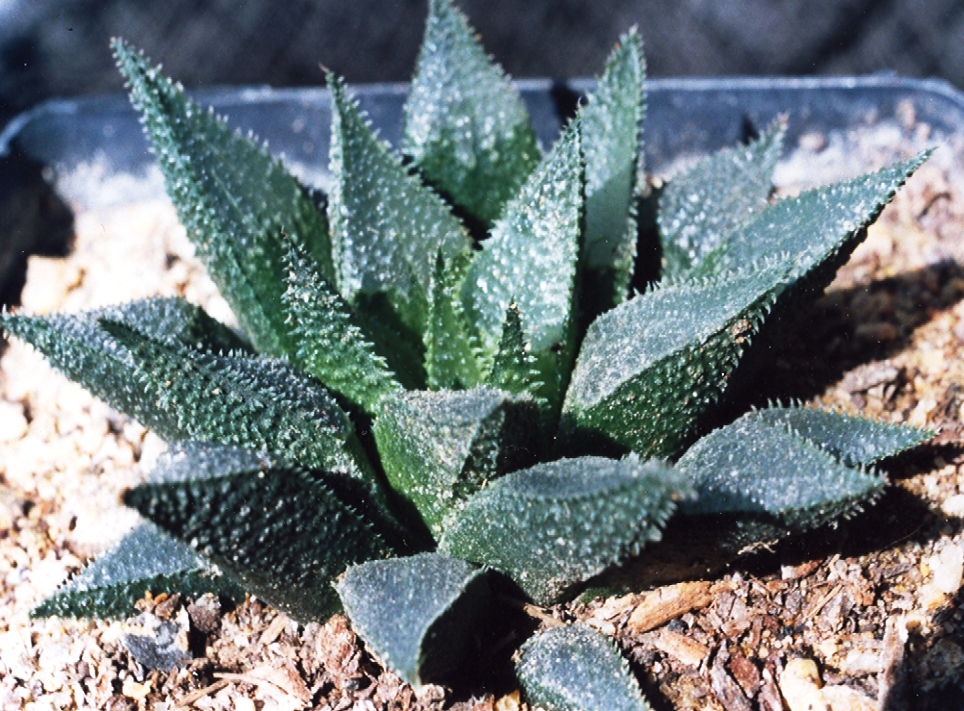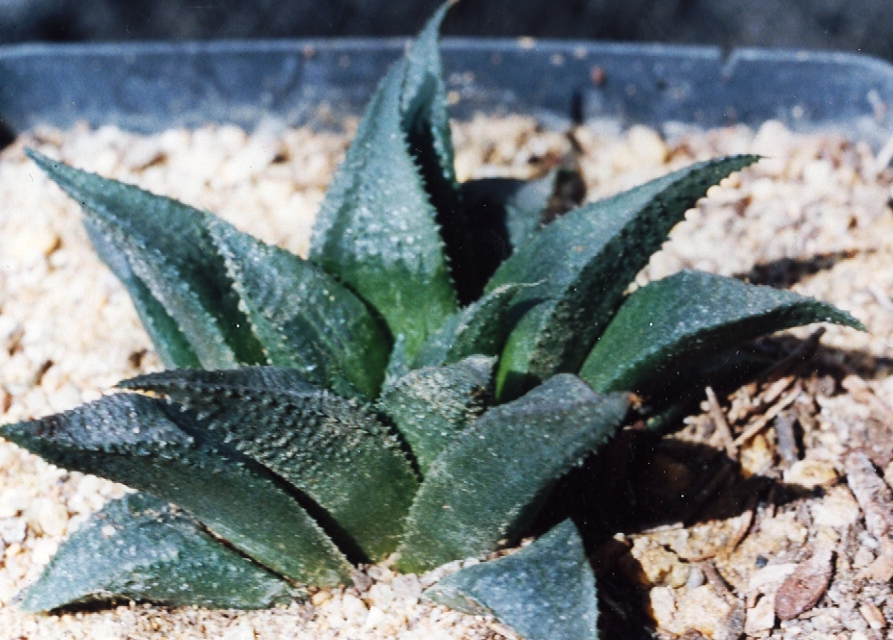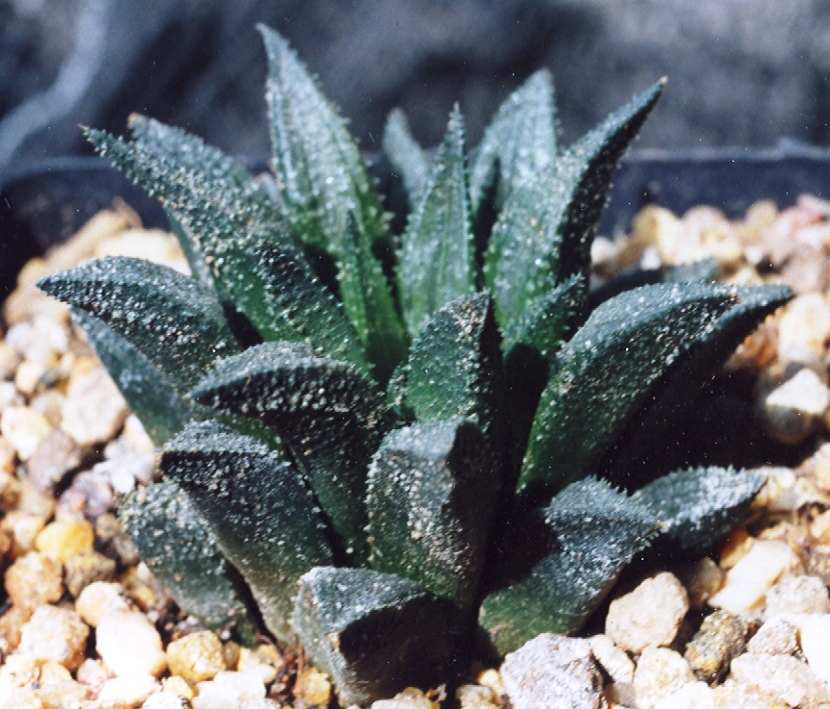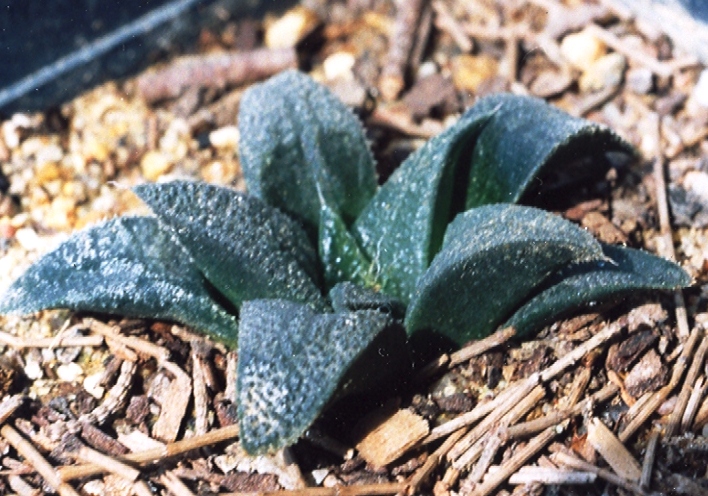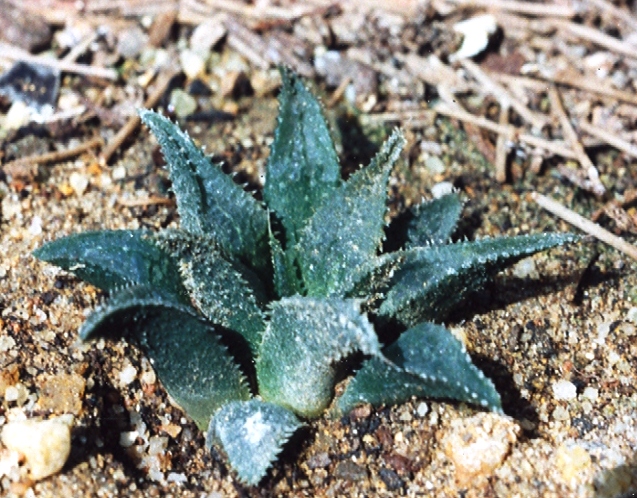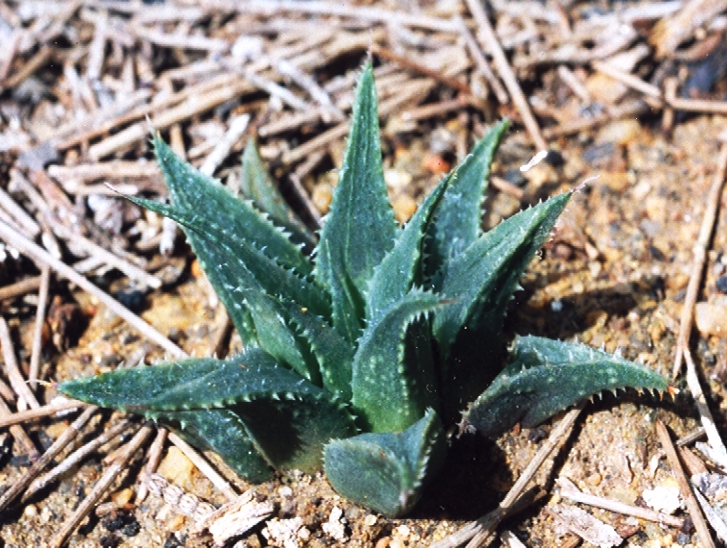Introduction:-
After writing Haworthia Revisited in 1996, I became aware of just how inadequate readers seem to be to the task of assimilating all the available literature on Haworthia, in the botanical and intellectual climate in which we live. It seems as though the more information we have the more confused we become. In order to generate the material needed to disprove or fortify my classification hypothesis, I have spent a further considerable amount of time in the field and in cultivating plants from seed. Unfortunately the editorial support and speed of publication has not kept pace with my own effort and much of my writing and my evidence is still in manuscript form. This short essay was therefore to put forward only a little more evidence to show just how complex plant species are – not necessarily only in Haworthia.
In my first Handbook (1976), I anticipated H. maraisii and H. magnifica to be separate species – the former west of, and the latter east of Heidelberg, Cape. In the second book (1982), I felt that I was dealing with a single species and referred to a population just west of Heidelberg as H. magnifica var. magnifica (instead of as H. maraisii). I did this transposition quite deliberately in order to suggest that the distinction between the two species was very arbitrary. In my later revision (1999) I separated H. magnifica and H. maraisii again. The rationalisation is given there and I just need to explain that I thought this was a better way of communicating the nature of the variable populations attached to each of two elements. It was then evident that populations relevant to magnifica and maraisii were proving to be more radically different than a single species hypothesis could comfortably accommodate. Also new evidence was accumulating for the nature of:-
1. H. heidelbergensis, which was not even included in the previous debates.
2. H. floribunda, also proving to be more variable than predicted.
3. H. mirabilis.
The overall relationship of these three species is far closer to both H. magnifica and H. maraisii than even my original conservative approach suggests.
In the essay which deals with H. floribunda I make two points particularly relevant to this article:-
1. The geographic facts, viz..”Westwards (from Gouritz River), the Swellendam area seems to provide a vegetation interval which H. turgida seems to bridge with difficulty, and which also marks some kind of a break for the H. magnifica/H. maraisii complex. This divide may be a function of inadequate collecting or the lack of adequate habitat”.
2. The populations known to me. To quote from the floribunda manuscript..”There are three more collections to be considered:- by Denis DeKok near Swellendam (Figs.25a, b & c MBB6644), about 10km west of Swellendam (MBB6861 not illustrated), and from the farm Rondeheuwel south of Stormsvlei (Figs.26a, b & c MBB6882, (Bayer in KG326/71). This latter collection has previously been reported (Handbook 1976) under one of the populations intermediate with H. mirabilis, and is cited in Haworthia Revisited under H. maraisii. These populations, as well as that southwest of Heidelberg (Figs27a, b & c MBB6663, Bayer in KG107/74 – cited under H. magnifica, Bayer, 1999) confound the issue enormously. Thus we actually have four populations which cannot with confidence be allied with either H. magnifica, H. maraisii or with H. mirabilis. The reality is that neither H. heidelbergensis nor H. floribunda can be excluded from the consideration of these populations. The case for each “species” needs to be dealt with separately”.
Primarily illustrated here are plants from the population MBB6644 which occurs west of Swellendam. The population is not remarkable for the variation observable there among the individual plants, and I have taken it to demonstrate that there was, and is, predictive value in my classification hypotheses. Much of my recent writing has been directed at the very weak concepts and perceptions that appear in our general understanding of “species” and their variability. This has an impact on individual credibility, plausibility and the truth with which we examine our human condition and pursue our hobbies.
Results:
The photographs depicted are all taken at virtually the same distance so that the size of the plants is relatively correct; with the largest plants being near 90mm diam. (the pots are 90mm square.
The first illustration depicts a conventional form of H. maraisii from a population from north of McGregor Fig. 1 MBB6646 H. maraisii var maraisii). The species was first described from Stormsvlei where the plants are a little larger and more tuberculate than these pictured. Actually it has become difficult to say just where this species stops and starts, and this will become obvious. There is a degree of translucence in the leaves and there is a conspicuous vein down the centre of the leaf. This is by no means a ‘character’ for the species, and an article could be written about the variation in venation as well as about this single population (MBB6646) too.
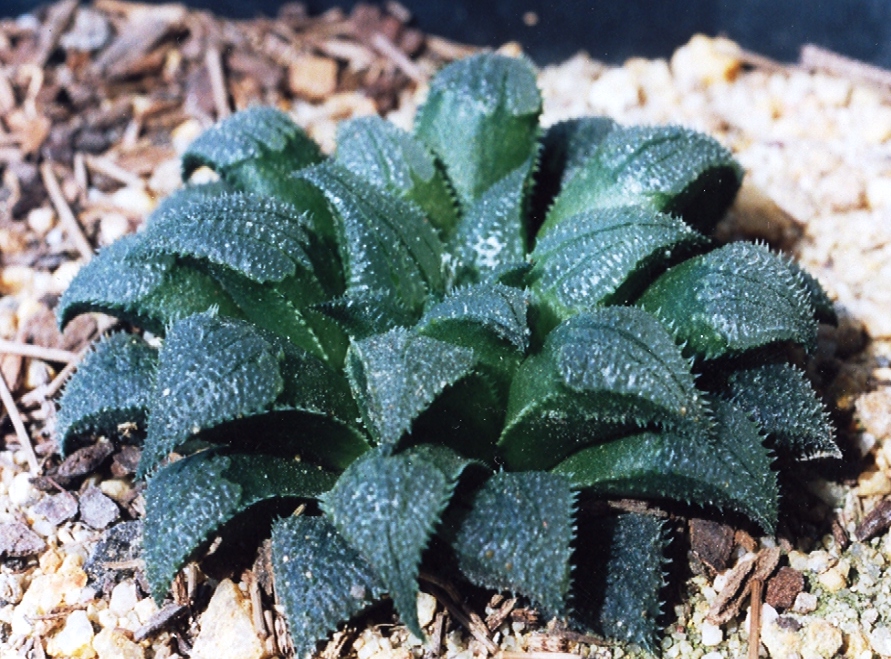
The Swellendam plants have been named as H. maraisii=mirabilis in the preceding chapter and are illustrated as follows:-
Fig.2, 3 and 4 are the clones 3, 8 and 17 of MBB6644. The surfaces are a little less tuberculate than the McGregor plant shown, but the only significant difference is actually that they are slightly bigger plants, the spination is more obvious and the leaves tend to be fewer and more erect. These are also by no means diagnostic characters. There is little translucence and the venation is inconspicuous. The identification of the population as H. maraisii thus seems obvious.
However, clones 2 and 4 illustrate a narrowing of the leaf (Figs.5 & 6 MBB6644). Clone 15 is a small plant also with smaller narrower leaves (Fig. 7 MBB6644). Were its leaves more erect instead of so recurved, it could be perhaps be taken to be H. heidelbergensis var. scabra.
Clones 1 and 3 (Figs.8 & 9) of MBB6663 are from west of Heidelberg and would easily be lost among the Swellendam plants if unlabelled. In the preceding chapter the population is identified as H. magnifica var magnifica. Clone 2 of this population (Fig.10 MBB6663) is a plant with more erect leaves – but…
Clones 7, 10, 11, 14 and 16 of MBB6644 (Figs.11 to 15) have a similar narrowing and erect bearing of the leaves, not to say that the plants are otherwise identical. This condition of the more erect leaves seems to be the more general one in both populations, MBB6644 and MBB6663. This is almost the crux of the problem in the classification of Haworthia, and in my experience it is not a problem unique to Haworthia. In all of biology there is this variability that requires statistical method to establish what “average” is. When one is dealing with different growing condition, and the nuances of texture, colour, shape, leaf recurvature and number, it is in fact not possible to generate such a “mean”.
Clones 9 and 13 of MBB6644 (Figs.16 & 17) are unusual in either H. maraisii or H. magnifica. The leaves tend to narrow quite considerably, but the leaves can also be unusually narrow and erect in populations of H. maraisii as in a population west of Robertson (Fig.18 MBB6647.8).
I include an illustration of a plant from a population of H. floribunda var. dentata from south of Swellendam (Fig. 19 MBB6881), – a population that tends to link floribunda with either maraisii or heidelbergensis to expose the reality that the link extends to H. mirabilis (apparently in a Dutch journal a writer has suggested that H. floribunda var. dentata is a form between H. floribunda and H. chlorocantha var. subglauca! This would be a complete misrepresentation of my classification hypothesis which has been fully explained and there is no reason for such a mistake. The var. dentata is represented by many populations and Chapter 3 details the possible relationship of the species floribunda and chlorocantha without any frivolity about the varieties and forms).
Also illustrated is a plant from a population very close (NW Kweekkraal), both geographically and in appearance, to H. magnifica var. atrofusca west of Riversdale (Fig.20 MBB6817). I have included it here because general colouration and texture are the same and it evidences the typical round-tipped leaves of floribunda which occurs so frequently in maraisii and magnifica (see older leaves in Fig.2 or Fig.8).
Clones 1, 5 and 18 of MBB6644 (Figs.21, 22 & 23) are small rather nondescript specimens, while is clone 64 of MBB6639 (Fig.24) is a plant of H. mirabilis var. sublineata from south of Bredasdorp. These last four illustrations depict a series of smaller plants which bear a resemblance to H. heidelbergensis. The difference in the latter is the lighter green colouration, slightly more translucence and more conspicuous spination. These are significant in the context of these collections and these photographs. However, put into the context of all the populations of H. heidelbergensis, H. floribunda, H. mirabilis, H. maraisii, H. magnifica, also H. emelyae and the total variability among these, it is impossible to stipulate difference.
The four problem populations, MBB6644, MBB6861, MBB6882 and MBB6663 are not as distinctive as suggested by the way in which I have specified them. They have also to be seen in the light of the variability of the individuals in those populations, and the many other populations which abut geographically onto them. Thus where I suggest they confound a clear difference between the two species H. maraisii and H. magnifica, this is not only how it is to be understood. The essay concerning H. floribunda will illustrate how extensive the problem actually is. These four populations can be discussed in terms of each of the species named in the previous paragraph.
One has to come back to biological variation and consider how one is to circumscribe a species in such a way as to facilitate identification. Here we have a single population in which the basic features such as colour, size, texture, spination, venation and translucence, are so variable that it is impossible to establish what the mean or average plant is. The problem is compounded by the fact that the variables can also not be broken down to discrete quantities. I have shown only the whole plant and thus the vegetative features. The flowers are less variable both within and between populations and ‘species’. It is already clear from the literature that species in the sub-genera of Haworthia can barely be separated on the basis of their flowers. To expect that the flower can then provide a ‘signature’ or character by which population variability can be understood, is fallacious. Floral character in fact must persuade one that there are less species than we wish to find from the vegetative characters which attract us to the plants in the first place. Flowering time is useful but it is also not diagnostic. Generally flowering time in the species mentioned in this article lies between September and May. It is no more useful than the geographic location of the population. H. maraisii tends to flower from March to May and H. mirabilis is generally earlier. However, to establish the actual flowering times for each population in terms of different seasons and years, and as a mean for the individuals in each population, must be a herculean task.
What I have done is to take geographic distribution as a key element in the classification. My experience is that distribution reflects the relationship between populations and between species. This is just a logical extension of the processes we should expect from speciation processes associated with genetic interbreeding, and isolation which obviates it. “Genetic drift” should reflect the probabilities associated with pollination across distance and with the nature of the pollinating agent. Similarities between populations should reflect this, as well as the probabilities of distribution by whatever agent such as wind or water. Naturally these will not be absolute, and the classification hypothesis will only be as good as the information allows, with the proviso that it is more information we are going to require if a better hypothesis is to be formulated.
What is striking in all my formal and informal communication with interested parties is the failure to appreciate what judgmental factors may underlie the vexing thing we regard as a “species”. I need to make it quite clear that I take a species to be a system of individuals judged on a very wide variety of factors – including geographical relationships and the influence these seem to have on other similar systems belonging to other genera. In Haworthia, I do not deceive myself that these systems are as discrete as my classification may suggest. That is why I wrote that I was recognising nodes in a complex interconnected array. Someone put forward their own solution to one such array by suggesting that the intermediate element be recognised as a species. This is particularly unacceptable when one considers the full implication. All the intermediates could be recognised as species and the present species then as intermediates! The position is that my classification was undertaken as a proper revision when a considerable amount of new data was available; sufficient to consider it really representative and adequate on which to base an overview of the genus. For persons now to suggest an alternative classification without a proper and thorough insight into all that old material, and without adding adequately to the known record, will border on the irresponsible and inconsiderate of the purpose of classification.
[1] Breckenridge (Haworthiad 19:4, 2005) for an example among others, admits to being wholly lost in respect of a remark I made (Haworthiad 18:44, 2004) in respect of varietal names. I wrote “…(variety) is a useful rank only if there is no typical variety, and if it is recognized that the species name is used for all the variants both formally named AND unnamed.” I was referring to the practice in nomenclature where the description of an inferior rank (variety in this case) automatically creates a “typical” rank. It is obvious that if a species is described from limited material, it is improbable that the description will include all the variants. Thus any new material of that species may differ from the described. Formally giving this new material a name should in fact broaden the initial description. If the ramifications of this fact are not apparent to the reader, then no amount of writing and explanation will lift the fog of misunderstanding.

